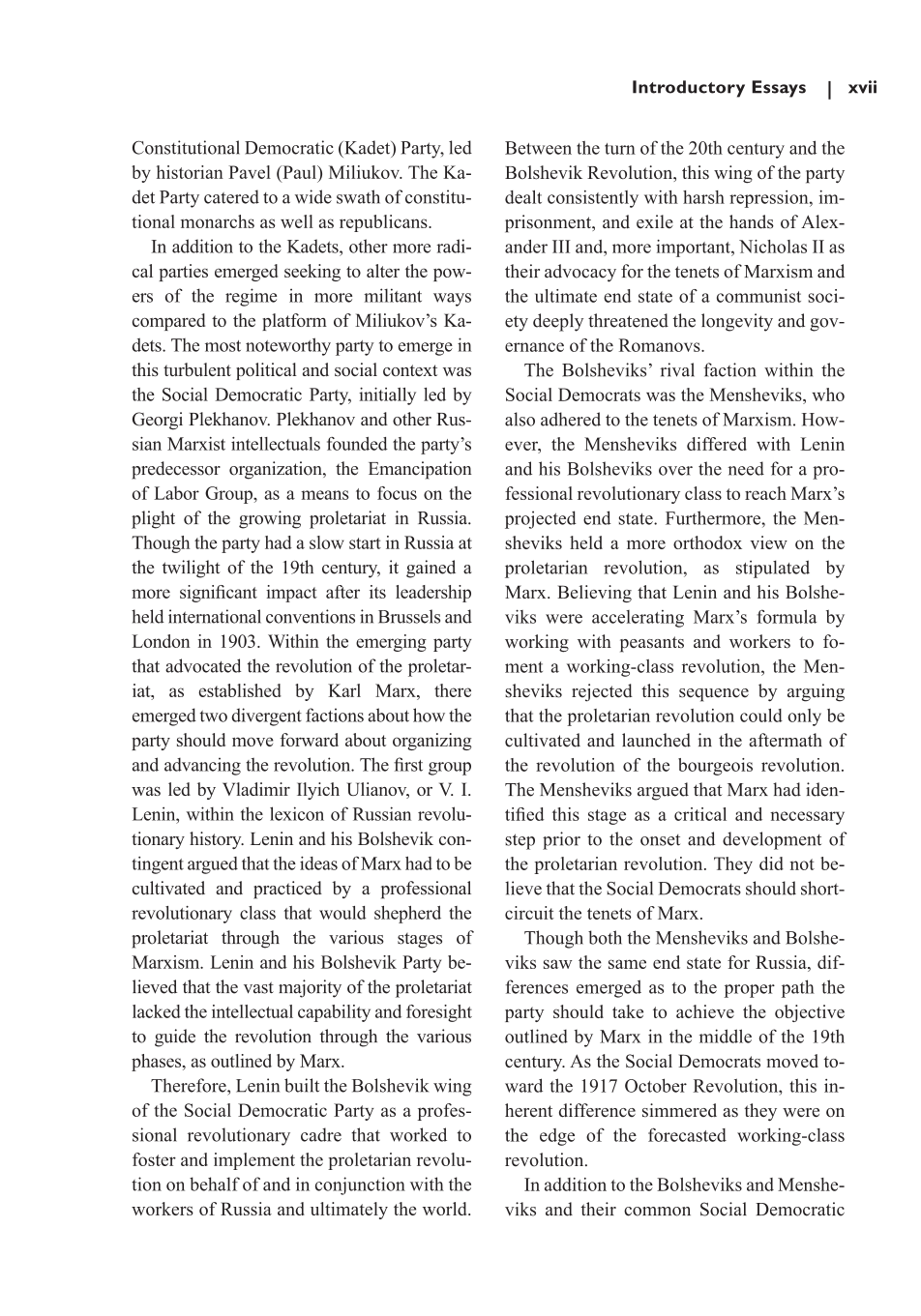Introductory Essays | xvii
Constitutional Democratic (Kadet) Party, led
by historian Pavel (Paul) Miliukov. The Ka-
det Party catered to a wide swath of constitu-
tional monarchs as well as republicans.
In addition to the Kadets, other more radi-
cal parties emerged seeking to alter the pow-
ers of the regime in more militant ways
compared to the platform of Miliukov’s Ka-
dets. The most noteworthy party to emerge in
this turbulent political and social context was
the Social Democratic Party, initially led by
Georgi Plekhanov. Plekhanov and other Rus-
sian Marxist intellectuals founded the party’s
predecessor organization, the Emancipation
of Labor Group, as a means to focus on the
plight of the growing proletariat in Russia.
Though the party had a slow start in Russia at
the twilight of the 19th century, it gained a
more significant impact after its leadership
held international conventions in Brussels and
London in 1903. Within the emerging party
that advocated the revolution of the proletar-
iat, as established by Karl Marx, there
emerged two divergent factions about how the
party should move forward about organizing
and advancing the revolution. The first group
was led by Vladimir Ilyich Ulianov, or V. I.
Lenin, within the lexicon of Russian revolu-
tionary history. Lenin and his Bolshevik con-
tingent argued that the ideas of Marx had to be
cultivated and practiced by a professional
revolutionary class that would shepherd the
proletariat through the various stages of
Marxism. Lenin and his Bolshevik Party be-
lieved that the vast majority of the proletariat
lacked the intellectual capability and foresight
to guide the revolution through the various
phases, as outlined by Marx.
Therefore, Lenin built the Bolshevik wing
of the Social Democratic Party as a profes-
sional revolutionary cadre that worked to
foster and implement the proletarian revolu-
tion on behalf of and in conjunction with the
workers of Russia and ultimately the world.
Between the turn of the 20th century and the
Bolshevik Revolution, this wing of the party
dealt consistently with harsh repression, im-
prisonment, and exile at the hands of Alex-
ander III and, more important, Nicholas II as
their advocacy for the tenets of Marxism and
the ultimate end state of a communist soci-
ety deeply threatened the longevity and gov-
ernance of the Romanovs.
The Bolsheviks’ rival faction within the
Social Democrats was the Mensheviks, who
also adhered to the tenets of Marxism. How-
ever, the Mensheviks differed with Lenin
and his Bolsheviks over the need for a pro-
fessional revolutionary class to reach Marx’s
projected end state. Furthermore, the Men-
sheviks held a more orthodox view on the
proletarian revolution, as stipulated by
Marx. Believing that Lenin and his Bolshe-
viks were accelerating Marx’s formula by
working with peasants and workers to fo-
ment a working-class revolution, the Men-
sheviks rejected this sequence by arguing
that the proletarian revolution could only be
cultivated and launched in the aftermath of
the revolution of the bourgeois revolution.
The Mensheviks argued that Marx had iden-
tified this stage as a critical and necessary
step prior to the onset and development of
the proletarian revolution. They did not be-
lieve that the Social Democrats should short-
circuit the tenets of Marx.
Though both the Mensheviks and Bolshe-
viks saw the same end state for Russia, dif-
ferences emerged as to the proper path the
party should take to achieve the objective
outlined by Marx in the middle of the 19th
century. As the Social Democrats moved to-
ward the 1917 October Revolution, this in-
herent difference simmered as they were on
the edge of the forecasted working-class
revolution.
In addition to the Bolsheviks and Menshe-
viks and their common Social Democratic










































































































































































































































































































